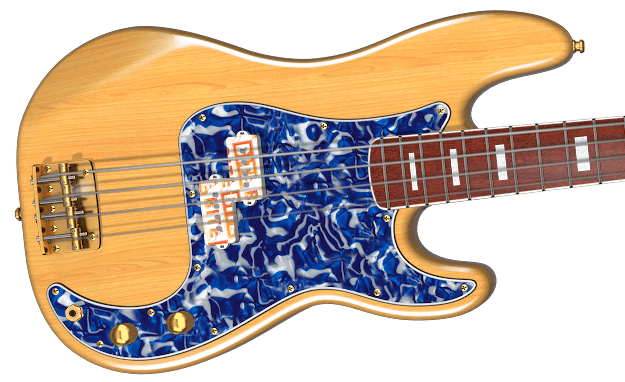
The Five BITE Custom Bass Models
1. The Punch
Features a symmetrical waist and a BITE 1000 mV split coil pickup, one coil in charge of E and A, the other one of D and G.
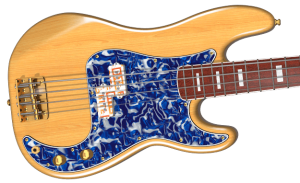
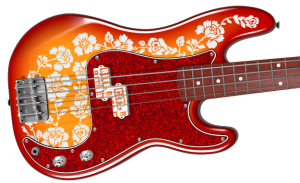
2. The Reverse Punch
It's a Punch with a reverse BITE 1000 mV split coil, i.e. the coils swapped places. Why would they do that?
Most bassists use the pickup as a thumb rest when finger picking. The D/G coil in its standard position easily gets in the way of the picking fingers. Toss the D/G coil over to the other side of the E/A coil and your fingers finally enjoy a free run.
Moreover, the treble strings D and G generally have a weaker output than the bassy E und A. This is the result of thinner cross sections and higher pitches. The standard array – D/G coil closer to the bridge than E/A – even adds to the D/G weakness. Let the coils swap places and you'll add a little punch to D/G while taking away some from E/A. What you get is a more even output across the strings.


3. The Jawbone JJ
Unlike the Punch, the Jawbone sports an offset body waist, and JJ stands for two BITE 1000 mV single coil pickups.
What's the deal with symmetrical and offset waists anyway? Historically, the symmetrical waist came first, it followed the shape of the acoustic guitar. Offset means shifting the lower waist closer towards the bridge. This shift is not only about the look but was designed by Leo Fender in 1960 supposedly to ease playing while seated. Did you ever try this out? Playing a JB sitting down, its waist resting on your right thigh? Actually, that's even less comfortable than the straightforward symmetrical PB-type waist.
Some argue the JB was meant to be played like a classical guitar, one foot elevated on a footrest, lower bout between your legs and guitar neck sticking up almost vertically. Well, this is one funny playing position.
Now add into the equation crossed legs while rehearsing at your desk and there you have it: complete anarchy about ergonomical advantages or disadvantages of an offset waist. The general upshot is that this whole seated playing thing is about individual preferences and an offset waist just adds a sporty touch to the body and that's that.

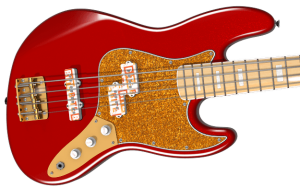
4. The Jawbone PJ
The Jawbone's PJ variant sports a BITE 1000 mV split coil in the neck position and a BITE 1000 mV single coil in the bridge position. The split coil delivers that punchy growl, the single coil some serious snap, and both together yet an entirely different acoustic pattern. You get the whole tonal bandwidth in one instrument, no wonder that the PJ configuration has become the most popular in recent years.
There is one more distinguishing feature about the BITE Jawbone PJ. While most available PJ basses have PB-type bodies, the Jawbone is a JB-type model. So what, you ask? Even in its standard position, the Jawbone PJ's split coil is closer to the neck and further away from its single coil, so you can expect the Jawbone PJ to be more versatile than your average PB-PJ.

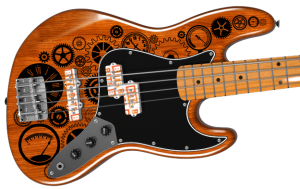
5. The Jawbone RPJ
It's a Jawbone PJ with a reverse split coil, thus uniting the benefits of the Jawbone PJ with those of the Reverse Punch. As far as we can see, it's also the only reverse PJ on a JB body basis far and wide.

The Wood Subject
Once in an Online Bass Forum
One guy asks which pickup he should install to get that korina tone from his korina bass.
Another one writes, "Korina tone?"
A third one, sarcastically, "Sure, punchy low end, sparkly highs and a pronounced mid-hump."
That was all it needed. The rest of the gang instantly jumps in, poking fun at the unsuspecting questioner.
This nicely sums up what every scientific exploration of the wood subject has found to date: no-one has ever been able to consistently identify the wood species just from the sound of an electric guitar or bass guitar.
The body of an electric bass is solid and 'electric' means electric sound generation. The oscillating string distorts the pickup's magnetic field, thus inducing electricity which is then transmitted and amplified through the signal chain. So far, so commonly known, no wood in this story.
Where's the Wood?
The wood establishes a firm but not too rigid connection between the string anchorage points at bridge and tuning posts. If this connection were too soft, it would absorb string vibrations and the tone would die off fast. If, on the other hand, it were too rigid, for instance a slab of stone, the stustain would be long, but we wouldn't like the lifeless sound.
Therefore, this connection must have certain physical properties, most important of all a low degree of damping which in turn depends on several parameters, including:
- Wood cut (Vertical or horizontal annual rings?)
- Number of layers (Is it a single grown piece of wood or multilayered glued laminated wood?)
- Residual moisture (How thorough was the drying process?)
- In addition, also the wood species has a small effect, as it chips in a typical tendency of properties, such as the density, to the equation. Why only a tendency? Even if you cut two bodies from one and the same trunk, they will never have identical weights and grain structures.
As we can see, there are many quality factors but a rather insignificant effect of the wood species. There are guitars and basses made of aluminum, acrylic, plywood or random wood such as reclaimed church pews and even entirely bodiless models. Many of those produce a decent sound.
What Matters More, Body or Neck?
When it comes to the wood subject, there has always been much talk of the body and little of the neck. Rightly so? Let's take a closer look.
One can roughly break down the distance between string anchorage at bridge and machine heads into thirds, the body accounting for one third, the neck for two thirds. – Ok, gotcha, the neck is in fact twice as important as the body, right?
Not so fast. The average cross section of the body is about ten times that of the neck. – Oh, I see, so the neck quality is in fact two times ten, i.e twenty times as decisive as the body quality, right?
Right … if only it weren't for the physical laws of the strength of materials. Because they say – with heaps of x and y and integral signs – that material stiffness is a multiple function of the cross section. In other words, forget the body, it's nothing but an oversize hook for marketing phrases. The wood quality of your neck has hundred times as much impact on your sound, and that's no exaggeration, it's math. Read here how we at BITE add extra stiffness to our necks.
People Listen with Their Fingers and Eyes
So where does all this talk about warm rosewood, crisp maple and whatnot come from and why is it so persistent even in the face of spectrographic counterevidence?
In our opinion, it has to some extent simple psychological reasons. Rosewood is dark and uncoated, so one can understand why people associate it with bassy and warm tonal qualities, whereas maple is blond and sealed, you touch cold polyurethane instead of natural wood. No wonder people attribute a trebly and cold sound to it.
Literature for the Sceptical and Curious
H. Lemme: Electric Guitar: Sound Secrets and Technology, 2012
L. Lospennato: Electric Guitar & Bass Design, 2010
M. Koch: Building Electric Guitars, 2001
M. Zollner: Physics of the Electric Guitar, 2014
R. H. Siminoff: Constructing a Solid-Body Guitar, 1986

Body Wood
If you explore the question why a certain bass model has always been made of a certain kind of wood, you often find a simple reason: this particular wood species has always been plentiful and affordable in the manufacturing region. It really is that simple and it means that many kinds of wood would serve the purpose.
The traditionally most popular wood species for electric bass bodies are alder, ash, basswood, mahogany and maple. We tested them in and out, up and down, inhouse and with external partners. Result: your cable length affects your sound more than your wood species, as long as the wood quality is within an acceptable range.

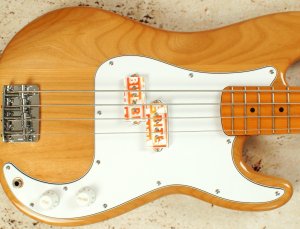
SO WHY IS THE STANDARD BITE BODY MADE FROM ALDER (ALNUS)?
1. Weight and Hardness
As a rule, alder weighs less than ash, mahogany and maple. The grab for the bass feels effortless, no more gigs bent forward in relieving posture. At the same time, alder is distinctly harder than basswood, which dents quite easily. A 34" BITE bass typically weighs between 3,7 and 3,9 kg on average, a 30" short scale between 3,0 and 3,2 kg respectively.

2. Availability
Alder being the most popular of all bass tonewoods, it is widely available in well-cut and dried grades.
3. Grain
While alder does not feature the distinct texture of ash or the openpored structure of mahogany, it is generally more handsome than maple and basswood and thus well-suited also for transparent finishes.
4. Sustainability
Alder grows in our northern latitudes. Its natural stock is rich and sound according to both CITES (Washington Convention) and IUCN (World Conservation Union).
We also offer lightweight builds from basswood and paulownia. Bodies are as a rule 2-to-3-piece laminated which is the international standard for solid bass bodies.
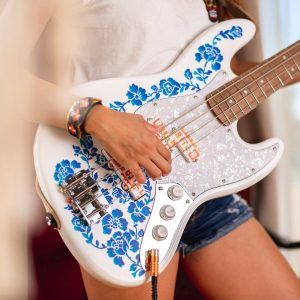
Downsized Body

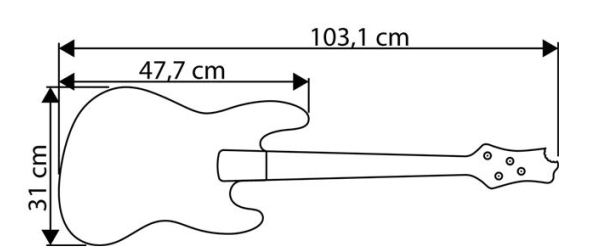


To make the BITE Custom Bass light and handy, we took away some wood in the waists, slimmed down the horns and we also took some fat off the butt, the so-called lower bout. The smaller frame lets the bass rest snugly against the player's body, especially while seated.
Height incl. bridge: 6,5 cm
Average Jawbone weight: 34": 3,9 kg (8.6 lbs)
Average Punch weight: 34": 3,7 kg (8.2 lbs)
30" short scale will reduce the bass weight by ard. 300 gr (0.7 lbs)
Note that bass weights always vary within a certain range due to individual grain structures, pickup and hardware features.


BITE 1000 mV Pickups
BITE 1000 mV pickups deliver destinctively more output across the entire frequency range of the fretboard than other pickups of comparable design. So what exactly does that mean? – BITE Custom Basses are really loud. Although they are purely passive basses, they have no battery compartment, you still might want to select active input mode on your bass amp.
BITE 1000 mV pickups were developed by BITE Guitars and are the result of several years of development cooperation with a major international pickup manufacturer. On top of this, we owe special thanks to the German GITEC Forum for Electric Guitar Technology and the University of Music and Performing Arts Vienna.
Our pickup development was aimed at maximizing output while maintaining a clearly defined tone. Why maximizing output? That is our understanding of bass. A bass needs persuasiveness and a strong presence, a clearly audible bass is the backbone of groove. You can always turn the volume down.
Everything you have downstream on stage, such as pedals, gain controls and whatnot, ultimately dilutes your sound. It's therefore all the more important that your output signal is clearly defined even with treble rolled off. A bassist should be able to clearly hear himself in the mix and it ain't bad either if everybody else including the last row way back realizes that bass is in da house!
In the BITE Guitars sound lab, output is measured electronically on purpose-built test instruments. This way we achieve the technically best possible repeatability and comparability of measuring results.
Our test instruments are designed in such way that the sweet spot of the open E string lies at 1000 millivolts (true RMS at 250 ms). Up to this point, output increases with good definition. Beyond, definition decreases distinguishably.
Peak values of other pickups with comparable design are measured at 300 mV. We therefore advise you to select active input mode on your bass amp or adjust gain control accordingly when playing a BITE Custom Bass.
BITE 1000 mV pickups come in three versions, as single coils, split coils and humbuckers. The single coil yields a typical JB sound, snappy and funky, the split coil sounds PB typical, it's a punchy heavyweight. Our model names Jawbone and Punch are derived from these sound properties. Finally, the humbucker is two single coils in series circuit for extra output.
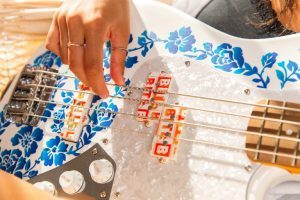


Open Seating
In both our models, Punch and Jawbone, you can optionally move the neck pickup – that's the one seated in the pickguard – forward towards the neck. The configurator offers you forward positions in ½ inch intervals.
Now why would you want to edge your pickup forward in the first place? This depends on what you have in mind with your bass. As a rule, the closer to the neck, the more massive your pickup will sound, but it will also loose clarity and definition.
The longer your note values are and the more punch you want to give your notes, the closer you should move towards the neck. By contrast, if you rather play fast lines with tight sequences, you're better off in the standard position.
However, this effect is clearly audible close to the bridge, whereas in the neck position, if at all audible, it comes mostly from the different finger plucking positions when using the pickup as a thumb rest.
You're not so sure about that whole pickup positioning thing? Would be nice, if you could just try and think about it? Actually, you can! All you need is a replacement pickguard from our SHOP with a differently positioned pickup routing. You can order it straight away together with your bass or anytime later.
Find out more about easy modification in the next chapter.
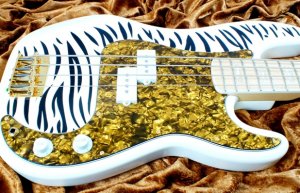


Modification as Easy as Never Before
Whatcha wanna do with your pickup? Nudge it around, swap its coils or replace it altogether? Your Punch or Jawbone Bass has a universal pickup cavity which accommodates the BITE 1000 mV single coil just as well as the split coil in traditional or reverse arrangement, and it allows you to choose your preferred pickup position.
If you can hold a screwdriver, you can modify your BITE pickup, because at your wish we also equip the pickup wires with snap connectors for solderless pickup replacement. You can select this option in the CONFIGURATOR.
Anything else you need for these modifications is a custom made replacement pickguard and, as the case may be, a replacement pickup. You can order anything you need in our SHOP.
You can also order all other spare parts in our SHOP including bodies and necks, just in case you want to reconsider the body color or your bass gets run over by the bus.
As regards modification work itself, we regret we cannot offer carrying it out ourselves due to capacity reasons. We perform repair work only in warranty cases. If you need some assistance though, we'll be happy to guide you by phone, text, WhatsApp or e-mail, or you might want to take your bass down to your local guitar repair shop.

